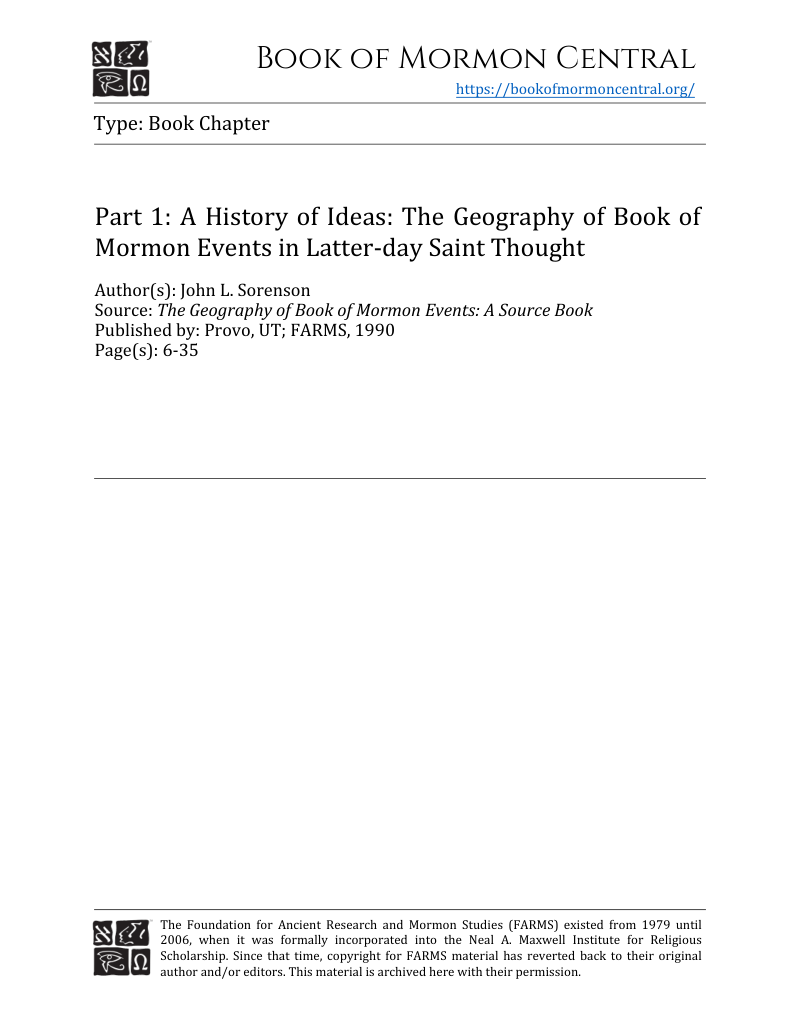John L. Sorenson reviews the history of BOM geography theories.
- Type
- Book
- Hearsay
- Direct
- Reference
John L. Sorenson, "Part 1: A History of Ideas: The Geography of Book of Mormon Events in Latter-day Saint Thought," in The Geography of Book of Mormon Events: A Source Book (Provo, UT: Foundation for Ancient Research and Mormon Studies, 1990), 6-35.
- Scribe/Publisher
- Foundation for Ancient Research and Mormon Studies
- Audience
- Reading Public
- Transcription
The approach to the record of the past known as the history of ideas takes the position that the apparent stream of thought or argument about an area of knowledge can be analyzed usefully by considering that the component concepts or notions in that stream have been produced by individual minds acting in given sociocultural settings at identifiable moments in time. The development of notions as they are visible down through time in the documents can be considered analogous to tributary streams running into a river system. The river itself may exhibit tortuous channels, eddies, backwaters and sinkholes in the sand in addition to receiving additions to its flow. For example, it is likely that some one person at one moment in history came up with the idea that the Magdalena River was the river Sidon, then that point was picked up by others. Another person at another moment first stated that the Usumacinta River was the Sidon, whereupon the two ideas were put into competition. And so on.
By isolating such contributions to thought, we may be able to clarify why certain geographical propositions flourished and others did not in terms of the intellectual, communicative and social settings of those who paid attention to these matters. Taken all together, such analyses have the potential to illuminate the channeling forces that have kept the stream of thought running within its evident banks instead of taking other lines. Only by trying to do this will we learn whether there is value in the picture produced that may free us of some unproductive historical predispositions. At the least we should be able to see better how far we are from the head of the river, and we may even glimpse its mouth. (Of course, those who do not accept the Book of Mormon as an authentic ancient document would say that this whole stream runs into an intellectual dead sea where nothing lives!)
Most historical material of interest here is organized not in terms of individual notions, ideas or geographical motifs but of "models." Each of those who have thought and written on the geography of Book of Mormon events has tended to develop a relatively consistent picture of the features fitted together. Such a picture I term a model. Thus the "Driggs 1925 Model" referred to later on consists of that set of geographical ideas represented in a brochure first printed (as far as I can tell) by Jean Russell Driggs in Salt Lake City in 1925. Since I am interested in the history of ideas, not just a publishing history, in cases where I am aware that a person crystallized a certain idea or constellation of ideas prior to the earliest formal publication accessible to me, I have dated the model from the earlier moment rather than from the publication date.
. . .
Note that two kinds of models are considered. An "external" model interprets Book of Mormon events as having occurred at a particular place in the western hemisphere. It provides a correlation between geographical features in the scriptural text and some specific American scene. We shall see that a large majority of the models published up until now have been external models. The other kind is, of course, "internal." Here the information in the text is analyzed and related with no reference to an external correlation; that is, constructing an internal model in the strict sense means ignoring all considerations of areas, rivers, isthmuses, ruins, etc. locatable on a map of the Americas. A number of such exclusively internal models have been published.
. . .
The models summarized and considered include those coming from persons in the tradition of the Reorganized Church of Jesus Christ of Latterday Saints. It is obvious in examining these that the originators paid attention to the more abundant LDS literature, hence ideas passed in the one direction without much regard to denominational boundaries. There is less evidence that RLDS views have had much circulation or effect among LDS writers.
Let us proceed by working through time from 1829 to the present, identifying periods of unusual interest and change in the consideration of geography and seeing what models and concepts originated and flourished when.
- Citations in Mormonr Qnas
The B. H. Roberts Foundation is not owned by, operated by, or affiliated with the Church of Jesus Christ of Latter-day Saints.

